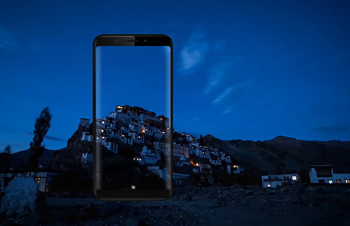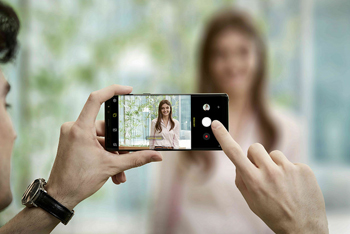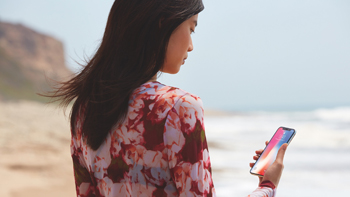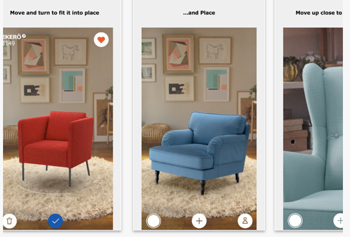The bezels shrank, the phones looked sharper. The displays got better and Apple unveiled a whole new Face Unlock technology that eclipsed the fingerprint sensor. 2017 was a year that saw the smartphone make giant strides and yet our one big crib still remained—battery life continues to be a jinx with many devices. We look back at some of the big trends of 2017 that will continue to dominate the smartphone experience in 2018:
The display, re-imagined
 Micromax Canvas Infinity 2
Micromax Canvas Infinity 2
It’s fair to say that it all began with the Samsung Galaxy S8. Samsung needed something special after the Note 7 PR debacle (it’s amazing how we’ve almost forgotten about it) and the Infinity display more than delivered the goods. Samsung shaved the bezels and made the smartphone display more immersive than it has ever been. It’s not just Samsung, the bezels started to vanish across the board. Micromax’s Canvas Infinity managed that with a device with a sub-Rs 10,000 price tag. And then the inevitable happened. Apple’s iPhone made a much needed break from its 2014 template (the iPhone 6 design) with an all new device that is all-screen—the iPhone X. In 2018, this is no longer going to be a novelty factor but a bare essential. The leaks of the new Sony devices for 2018 suggest an all-screen form factor. As the bezels disappear and the displays stretch (the 6.3-inch Samsung Galaxy Note 8 can slip into your jeans), video consumption and Netflix binge watching is moving to the smartphone. Will we need our 7-inch tabs or iPads at all?
The dual camera
 Portrait mode on the Samsung Note 8 with dual camera
Portrait mode on the Samsung Note 8 with dual camera
A trend that took wings in late 2016 with the iPhone 7 Plus, LG G5 and the Huawei P9. However, it truly went mainstream in 2017 almost becoming a deal breaker in the premium segment. Every brand seems to have taken a different approach and that’s a great thing if you are a consumer. You can choose a phone that uses its dual camera to fix lowlight photography (like the One Plus 5T) or the wide-angle lens of the LG V30. You might choose the iPhone X or the 8 Plus if portraits are your scene. The smartphone camera has certainly got better in 2017; lowlight photography and the zoom lens are a case in point. 2018 could see smartphone cameras break new ground. We’ve been hearing rumours about how the new Samsung Galaxy S9 might actually feature a variable aperture that could radically alter the quality of lowlight photography.
Face unlock
 Face Unlock on iPhone X
Face Unlock on iPhone X
When Samsung and Apple expanded the display, they both followed different strategies to deal with the fingerprint sensor. The iPhone X gave it a boot, replacing it with FaceID. It didn't stop with just unlocking your phone but also became your one point access to your Apps and Apple Pay. FaceID hasn't quite won support across the board. Apple put a lot of thought and technology, cramming a tiny area above the screen with a bunch of sensors, and yet FaceID doesn't always work the way you want it to. Samsung’s Iris Sensor is clearly work-in-progress while the awkward position of its fingerprint sensor (in the S8 and Note 8) is one of the only slight flaws in the device. You might be sceptical about Apple’s FaceID but we’re clearly headed in that direction in 2018. Leaks suggest that we could well see more improvisations in FaceID and a much improved Iris scanner in the Samsung S9—with improved detection in lowlight environments.
Augmented reality
 Ikea Place App
Ikea Place App
One of the big takeaways of the iPhone X and 8 launch event was Apple’s huge endorsement of AR. All our tech experiences and interactions like ‘pinch to zoom’ on a mobile screen, are all two-dimensional. It’s why the extra dimension that AR adds is going to open up a whole new set of possibilities. In just three months we’ve seen immersive games and clever apps, like the Ikea place app that allows consumers to place objects from within Ikea’s catalogue into their living spaces. Not all the action is on the iOS platform. We enjoyed checking out the ASUS Zenfone AR with Google’s Tango baked in. The Tango app store is certainly not as crowded as the Google Play Store but there’s enough to showcase the potential of AR. For instance the BMW ‘i visualiser’ app allows you to step into a life-size BMW car and play around with the controls and customise the interiors. We’re going to see more gaming experiences and brand interactions in 2018 as augmented reality or mixed reality truly comes alive.





